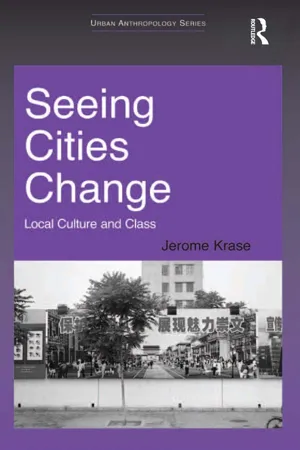Geography
Cultural Traits
Cultural traits refer to the specific customs, traditions, and behaviors that are characteristic of a particular society or group. These traits can include language, religion, food, clothing, and social practices, and they are passed down from generation to generation. In the context of geography, cultural traits play a significant role in shaping the unique identity and characteristics of different regions around the world.
Written by Perlego with AI-assistance
3 Key excerpts on "Cultural Traits"
Learn about this page
Index pages curate the most relevant extracts from our library of academic textbooks. They’ve been created using an in-house natural language model (NLM), each adding context and meaning to key research topics.
- Nuala C. Johnson, Richard H. Schein, Jamie Winders(Authors)
- 2013(Publication Date)
- Wiley-Blackwell(Publisher)
It is hard to find a key word or topic in cultural geography these days that does not enjoy an interdisciplinary constituency. That is a good thing. The contemporary fascination with the “cultural” has generated an enormous body of work on which cultural geographers draw and to which they contribute. Cultural geography as a subdiscipline brings to the conversations a long tradition, most notably attention to space and place, to the spatiality of everyday life at multiple and fluid scales, to landscapes as the re-suturing of human and physical worlds, and to the politics and epistemological implications of these engagements. In the past decade, these traditional foci have remained intact, even as some have garnered renewed enthusiasm (such as nature–society questions), others have undergone increased conceptual scrutiny (such as the “cultural landscape” concept), and many have engaged new conceptual or theoretical possibilities (such as increased interest in affect and emotion or consideration of the “posthuman”). All of these developments are present in this volume, and this introductory chapter signposts some of these traditional, new, and renewed areas of interest in cultural geography and the ways these topics have shifted in the last decade. This chapter is not, however, meant as a comprehensive introduction to the subdiscipline of cultural geography. Instead, it is an invitation to examine the field’s ever-changing contours through the ensuing essays.Cultural geography has been a foundational building block of human geography since the discipline formally was established in the nineteenth century. Documenting spatial patterns in human interaction with, responses to, and transformations of the natural landscape, raising questions about how landscape itself was shaped by and shaped social dynamics, and problematizing the ideas of culture, landscape, and nature have been cultural geography’s contributions to the ways that human geographers have thought about the world around them, past and present. Today, the line between human geography as a discipline and cultural geography as a subdiscipline is blurred to the point that cultural geography is human geography in some corners of our field. Recent intellectual and scholarly developments within geography have drawn cultural geographers closer to the fold and to deeper engagements with colleagues and ideas once thought beyond cultural geography’s purview – political, economic, historical, or environmental geography, for example. These connections have been strengthened through cultural geography’s embrace of and relevance to the so-called cultural and spatial turns across the human sciences as well as its engagement with social theory and concepts of interest to a broad range of scholars within and beyond the discipline. In short, cultural geographers today study nearly every aspect of human geography and do so in ways that simultaneously reinforce the subdiscipline’s place in geography and question the logic and locations of its boundaries.Cultural geography is itself deeply geographic in terms of what places and spaces cultural geographers study and how cultural-geographic scholarship is conducted across institutional and national contexts. Although cultural geography developed historically and intellectually in relation to other areas of human geography, such as cultural ecology and social geography, it also has developed in relation to its practical and institutional contexts. Cultural geography means different things in different places and is enacted in different ways, especially between its North American and British variants (see, for example, Audrey Kobayashi’s discussion of this phenomenon in relation to geographic treatments of race in Chapter 9). Where- eBook - ePub
Seeing Cities Change
Local Culture and Class
- Jerome Krase(Author)
- 2016(Publication Date)
- Routledge(Publisher)
Cultural landscapes can range from thousands of acres of rural land to homesteads with small front yards. They can be man-made expressions of visual and spatial relationships that include grand estates, farmlands, public gardens and parks, college campuses, cemeteries, scenic highways, and industrial sites. Cultural landscapes are works of art, texts and narratives of cultures, and expressions of regional identity. They also exist in relationship to their ecological contexts” (2009). The Geographer Carl O. Sauer had perhaps the greatest impact on a broad spectrum of social and cultural studies by emphasizing the power of humans to modify the visible features of the Earth’s surface and in the process create cultural landscapes. For early German geographers, the term Landschaft (landscape) was an area identified by visible, physical, and cultural features. The work of Sauer and others at the Berkeley School of Cultural Geography expanded the scope of geography by reducing the environmental determinism that had dominated the study of landscapes by geographers. Historically, the study of Cultural Landscapes was essentially a national project that focused especially on the lasting effects of founding cultural groups. In the United States the founding groups were its earliest Anglo-Saxon settlers. As a result, the search for the quintessential “American” character showed an historical small town and rural bias. Later immigrants, especially those who came to America after the middle of the nineteenth century, were seen as environmental interlopers and their impact on America’s Cultural Landscape was generally viewed as a mere modification of that which was already established. However, except perhaps for those of Native Americans, all of America’s building traditions have come from abroad - (Author)
- 2020(Publication Date)
- Wiley(Publisher)
Personality and GeographyPeter J. RentfrowUniversity of CambridgeGeographical Variation in Personality
For decades, research in the geographical sciences has documented regional variation in political attitudes, educational attainment, social tolerance, and disease death rates. Importantly, research in personality psychology has established robust associations between certain personality traits and political orientation, academic performance, occupational preferences, prejudice, and health. To what extent do regional differences in macro‐level outcomes reflect the psychological characteristics of residents?Research on geographical variation in personality stems from the recognition that various features of the social and physical environment are linked to the ways in which individuals think, feel, and behave. Investigations of geographical variation in personality integrate psychological theories and concepts with different levels of geographic analysis (e.g. nations, states, cities, neighborhoods) by focusing on the spatial distributions of traits and the ways in which they relate to the macro‐environment. Research on geographical variation in personality shares some overlap with cross‐cultural studies of personality, as both areas focus on associations between personality and the broader environment. But cross‐cultural studies typically focus on cultural symbols, practices, and norms whereas geographical comparisons examine issues related to spatial organization (Rentfrow, 2013 ).History
Nearly a century ago, social scientists began studying the relations between people and the places in which they live. The focus of the research was to identify the key psychological characteristics that defined and differentiated nations. The studies investigated a range of characteristics, including personality, attitudes, motives, and values. A variety of assessment methods were used, with most studies relying on interviews, observations, and surveys. The information gleaned from the research was thought provoking and controversial, but the findings nevertheless informed psychologists’ understanding of culture, group conflict, economic prosperity, and personality. Ultimately, however, the research had limited impact in psychology and interest in geographical differences faded away (LeVine, 2001


